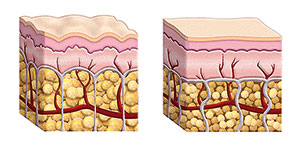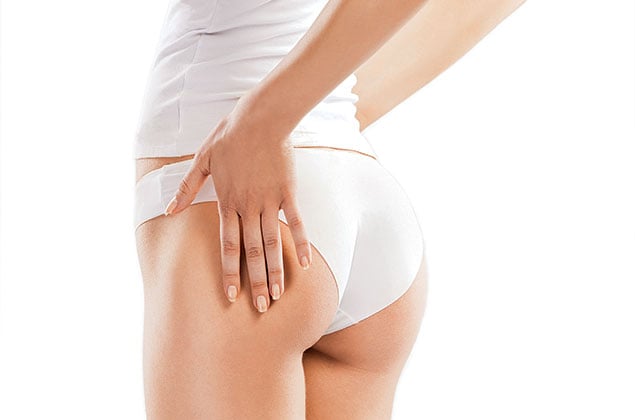“How do I get rid of cellulite?”
It’s a question dermatologists and plastic surgeons get asked a lot. Unfortunately, most admit there’s no simple answer.
“If there was some easy way to get rid of cellulite, we’d all be doing it by now,” says Maral Kibarian Skelsey, director of dermatologic surgery at Georgetown University Medical Center.
The silver lining is that you’re not alone in the fight against the lumps and bumps that can cover thighs, hips, even arms and the stomach. Some 90 percent of women have cellulite—most just don’t care to admit it.

What Is It?
“Cellulite is, unfortunately, very much of a female condition,” says Fairfax plastic surgeon George Bitar. The key to understanding why it discriminates against women lies deep beneath the skin.
Although cellulite appears on the surface, it’s found in the layer of fat below the epidermis and dermis. That’s where pockets of fat sit sandwiched between septae, fibrous bands that connect to the skin and penetrate down to the muscle.
In men, septae are crisscrossed and act like mesh, keeping the fat in place. In women, however, not only do the bands run vertically and less frequently, but they’re weaker.
“In women, the bands pull down in such a way that causes dimples on the surface of the skin,” says dermatologist Melda Isaac of MI-Skin Dermatology Center in DC. “In between the bands are fat cells that accumulate and get trapped, then push up into the skin and cause the bumpiness.”
Genetics also play a role. Our genes determine how much fat we have to begin with, Skelsey says, as well as the thickness of our skin. Thick skin masks the appearance of cellulite more than thin skin. “You can’t do much about that unless you change your parents,” she says.
While cellulite can develop at any age—even among teenagers—its appearance worsens as we grow older and lose skin elasticity and muscle tone. The skin weakens over the years, Isaac says, “so there’s no spring to it, and cellulite looks even more accentuated.”
Treating It
Why is cellulite so hard to treat? Until now, efforts to banish the condition have been futile because the focus of treatment was misguided, Isaac suspects. “For a long time, I think we were addressing the wrong pathology,” she says. “We weren’t focusing on the architecture of cellulite.”
Skelsey agrees, pointing out that the first thing to come to terms with is that cellulite can’t be completely cured: “It’s not a disease,” she says. “It’s an anatomic variation.”
Be wary of creams and compression clothes that claim to get rid of cellulite. “If it sounds too good to be true, it usually is,” Bitar warns.
One tried-and-true method of reducing the appearance of cellulite is strength training. While there’s no research on the role of exercise with cellulite, Isaac says to keep in mind that the septae connect to muscle under the fat layer. Therefore, resistance training will not only burn excess fat but also promote muscle definition and smoother skin. “You can improve the appearance by making muscles leaner and stronger,” she says.
The same goes for healthy eating. While nutrition alone won’t reduce cellulite, it’s a good idea to eat a balanced diet with lots of vegetables, fruits, and protein and to avoid crash diets, which aim for rapid weight loss over a short time. While a diet can reduce fat, “it doesn’t reduce dimpling,” writes Dr. Howard Murad in The Cellulite Solution. And extreme weight loss, Isaac adds, can make the appearance of cellulite worse.
“Diet and exercise are terrific for health and staying in good shape,” says Fairfax plastic surgeon Robert F. Centeno, “but there are millions of women who are in extremely good physical condition who still have cellulite. You can do everything right—have completely normal weight and a terrific diet—and still have cellulite because anatomical issues predispose you to it.”
One promising treatment is a form of laser therapy that addresses the inner workings of cellulite, says Skelsey, who is a consultant on the Food and Drug Administration’s general-and-plastic-surgery-devices panel. These devices, such as the recently FDA-approved Cellulaze, aim to get rid of cellulite by zapping the septae and melting the fat in one session. The goal is for the fibrous bands to reform in a different pattern that’s less cellulite-prone.
Even then, it’s likely that patients would need annual touchups. Still, laser therapy is “as close to a magic bullet as we have,” says Bitar, whose practice is one of 22 medical centers in the country that use CelluSmooth, a similar laser device.
Until that magic bullet appears, Skelsey says there’s one thing to keep in mind about cellulite: “It’s normal. But if it’s something that’s really bothersome to a person, there are a few things out there—a very few. The best thing you can do is do your research and have realistic expectations about what kind of results your investment is going to make.”
This article appears in the December 2013 issue of Washingtonian.



















